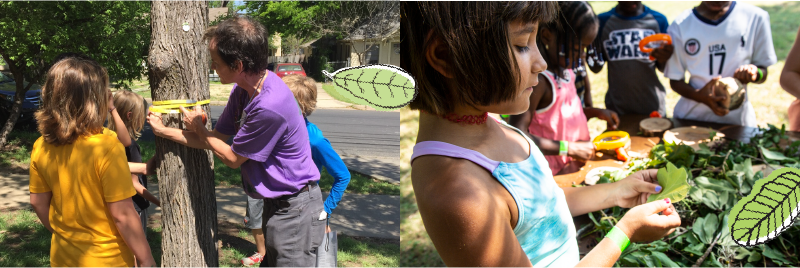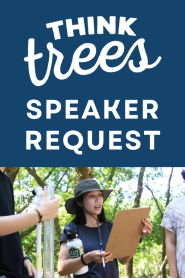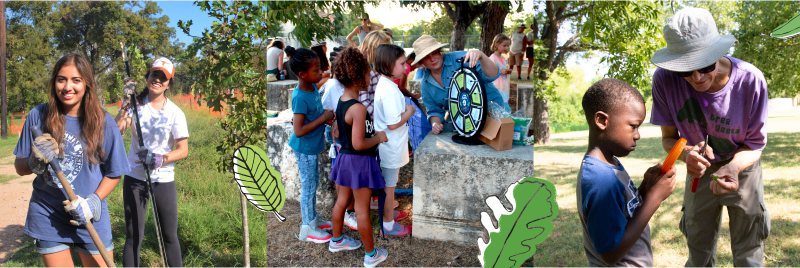
Our mission is to enhance Austin’s quality of life by fostering a healthy urban forest for all. With youth programming, we provide materials, training, and resources to connect young people in Austin to the trees that help make our city special. We invite you to explore all that we have to offer.
Many of the materials and activities available on this page were created by members of the Youth Forest Council.
- Games, Activities, and Materials
-
Use the tabs below to explore offerings from the Urban Forest Program. These items are available to download for use in your home, classroom, youth group, or nearby nature. Looking for printed materials for a group? Use the Materials Request Form tab to request printed materials for the young people you work with.
Click on the name of an activity to download and print. Don't have a printer? Request materials for your classroom or youth group using the Materials Request Form.
- Friends of the Urban Forest: Meet some of the local animals that rely on our city’s trees. (Single page download; 1.2 MB)
- Chinquapin Oak Leaf: Color in your own Chinquapin Oak leaf and acorn. (Single page download; 0.7 MB)
- A Guide to Austin’s Forest Coloring Book: Learn about our local trees and the creatures that rely on them with this printable coloring book. (Multi-page download; 6.3 MB)
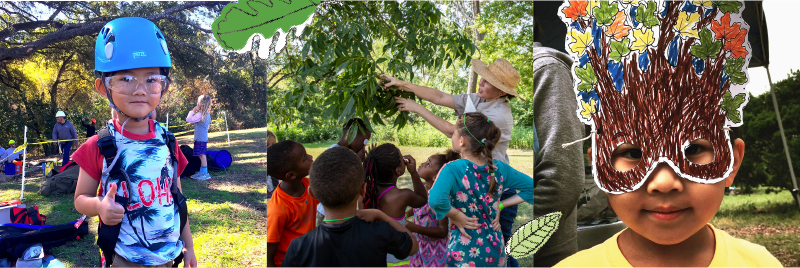
Printable Activities
- Super Sapling Activity Books: Become a Super Sapling Superhero by completing one of our Super Sapling adventures! Do you like noticing the world around you and using your imagination? In the Artist Scientist Activity Book (42 MB), explore shapes, colors, and more in the outdoors. Prefer to use your detective skills to look for signs of local animals? Check out the Habitat Investigator Activity Book (8.2 MB).
- Bigtooth Maple Mask: Design this printable tree mask to become one with nature. Created by the Watershed Protection Youth Education team. (2.4 MB)
- Trees of Central Texas Word Search: Learn cool facts about Central Texas Trees with this word search created by a 2020 Youth Forest Council member. (1.7 MB)
- Acorn Maze: Help Charlie the Acorn move from his tree branch to the ground so that he can grow into a healthy oak tree. (0.7 MB)
- Word Puzzle Page: Help Charlie the Acorn solve a number of tree-themed word puzzles, including a word search and word jumble. (0.6 MB)
- Urban Forest Chatterbox: The classic fortune-telling game gets a tree-themed update. Discover small actions you can take to support nature near your home. (1 MB)
Online Experiences
- Youth Forest Gallery: Visit the virtual gallery to view tree-inspired artwork and stories shared by young people from all over Austin. This Youth Forest Gallery was created by a 2020 Youth Forest Council member.
- Barton Creek Greenbelt Interactive Tree Tour: Explore the trees of the Barton Creek Greenbelt with this interactive StoryMap. This interactive tour was created by a 2020 Youth Forest Council member.
- Take a 3D Tour of Swede Hill Pocket Park: Parks do not have to be large to offer a great chance to explore nature in your neighborhood. Visit one of Austin’s pocket parks with a member of the 2020 Youth Forest Council.
Find more games and activities at the Roots & Wings Festival’s Nature Activities webpage.
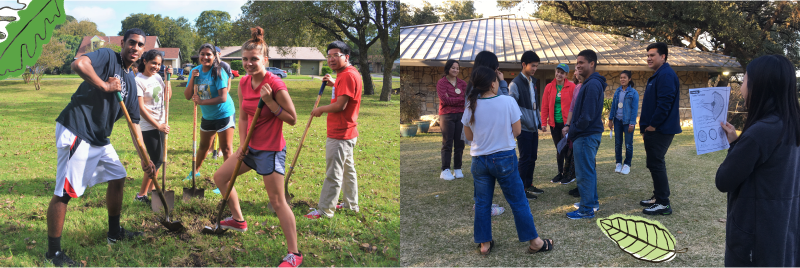
We are happy to provide materials for you to share with the young people you work with — whether in a nature program, classroom, or less formal youth group. To learn more and request available materials, please complete the Urban Forest Program Materials Request Form below or open the form in a new window.
Please note: Completing this form does not guarantee that the Urban Forest Program will be able to provide the materials requested. We review all material requests based on our current availability, alignment to our program's mission, and community priority (as based on the Community Tree Priority Map). Materials are available free of cost. We ask that you please request the quantity you plan to distribute. Small requests (under 10 items) and large requests (over 100 items) may be more difficult to accommodate.
- Friends of the Urban Forest: Meet some of the local animals that rely on our city’s trees. (Single page download; 1.2 MB)
- Trainings and Internships
-
Youth Forest Council
For young people ages 16-19
The Youth Forest Council (YFC) is a yearlong paid internship for young people ages 16-19 in the Austin-area. YFC members grow their professional network, plan community events, and further cultivate a connection to nature in our city, both for themselves and for other Austinites. Applications open each spring. Learn more about the Youth Forest Council.
Project Learning Tree
For educators and others who wish to connect children to nature
Project Learning Tree is an award-winning environmental education curriculum aligned to state standards, including the Texas Essential Knowledge and Skills (TEKS). Project Learning Tree utilizes a train-the-trainer model to advance environmental literacy and promote stewardship. The Urban Forest Program offers occasional certification programs in Project Learning Tree for teachers and educators of all ages across the Austin area. Interested in learning more? Complete the Project Learning Tree interest form.
Youth Leadership Working Group
For young people and those who work with them
We are proud to take part in the Cities Connecting Children to Nature Austin initiative, including the Youth Leadership Working Group. We encourage young people (and those who work with them) from across Austin to join the working group. These monthly meetings offer a chance to connect with peers, green professionals, and nature. In the working group, young people can build on their leadership skills, learn about green careers, and work together towards environmental justice. Interested in joining? Email the Cities Connecting Children to Nature Coordinator.
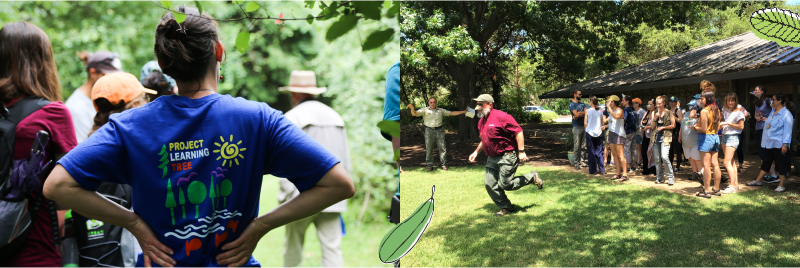
- Funding for Your Projects
-
Bright Green Future School Grants
The Urban Forest Program is proud to partner with the City of Austin Office of Sustainability on the Bright Green Future School Grants to fund tree-related projects at schools across Austin. The program recognizes and supports innovative projects that will inspire students to become lifelong environmental stewards. Bright Green Future School Grants provide up to $3,000 per project for school-based sustainability initiatives through a competitive funding process. Applications for the program are typically accepted from mid-August through September each year.
Urban Forest Grant
The Urban Forest Grant strengthens Austin’s urban forest by funding stewardship activities like tree planting, tree care, education, and disease control projects. We encourage educators, parent-teacher organizations, and nonprofit groups interested in forestry-related initiatives to apply for the Urban Forest Grant.
Neighborhood Partnering Program
Through the Public Works Department’s Neighborhood Partnering Program (NPP) Austin residents can work together to enhance the places they live, work, and play. There are several opportunities available through NPP, including a grant assistance program that provides matching funds to groups applying for external grants. To be eligible for the Neighborhood Partnering Program, proposed projects must be on City-owned property or right of way and be submitted by a local group, such as a neighborhood association, community organization, or other non-profit entity.
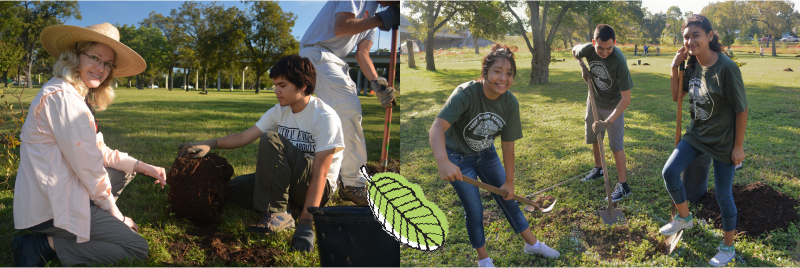
- About Austin's Urban Forest
-
What is an urban forest?
The term "urban forest" describes the collection of individual trees that grow within a city. “Urban forestry” is the practice of caring for and managing those trees. All the trees within the City of Austin help make up our urban forest, including trees in parking lots, along streets, in parks, or even in your own yard. Trees play an important role in our urban communities, including cleaning our air and water, providing refuge for wildlife, and improving health outcomes for the people who live there.
Fun facts about Austin’s urban forest...
- There are more than 33 million trees in the City of Austin.
- Austin is home to a large number of fruit and nut trees that help provide delicious treats for people and wildlife in our community, including pecans, figs, loquats, and mulberries. Yum!
- The five most common tree species in Austin are the Ashe Juniper, Cedar Elm, Live Oak, Hackberry, and Texas Persimmon. Can you find them all?
Want to learn more?
- Visit the Tree Information Center.
- Explore Austin’s Community Tree Report.
- Learn about the Community Tree Priority Map.
